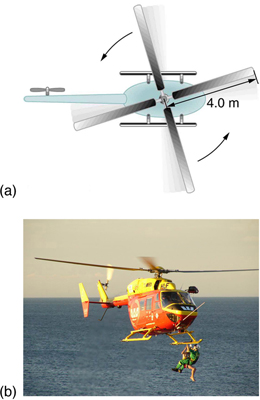| << Chapter < Page | Chapter >> Page > |
A typical small rescue helicopter, similar to the one in [link] , has four blades, each is 4.00 m long and has a mass of 50.0 kg. The blades can be approximated as thin rods that rotate about one end of an axis perpendicular to their length. The helicopter has a total loaded mass of 1000 kg. (a) Calculate the rotational kinetic energy in the blades when they rotate at 300 rpm. (b) Calculate the translational kinetic energy of the helicopter when it flies at 20.0 m/s, and compare it with the rotational energy in the blades. (c) To what height could the helicopter be raised if all of the rotational kinetic energy could be used to lift it?
Strategy
Rotational and translational kinetic energies can be calculated from their definitions. The last part of the problem relates to the idea that energy can change form, in this case from rotational kinetic energy to gravitational potential energy.
Solution for (a)
The rotational kinetic energy is
We must convert the angular velocity to radians per second and calculate the moment of inertia before we can find . The angular velocity is
The moment of inertia of one blade will be that of a thin rod rotated about its end, found in [link] . The total is four times this moment of inertia, because there are four blades. Thus,
Entering and into the expression for rotational kinetic energy gives
Solution for (b)
Translational kinetic energy was defined in Uniform Circular Motion and Gravitation . Entering the given values of mass and velocity, we obtain
To compare kinetic energies, we take the ratio of translational kinetic energy to rotational kinetic energy. This ratio is
Solution for (c)
At the maximum height, all rotational kinetic energy will have been converted to gravitational energy. To find this height, we equate those two energies:
or
We now solve for and substitute known values into the resulting equation
Discussion
The ratio of translational energy to rotational kinetic energy is only 0.380. This ratio tells us that most of the kinetic energy of the helicopter is in its spinning blades—something you probably would not suspect. The 53.7 m height to which the helicopter could be raised with the rotational kinetic energy is also impressive, again emphasizing the amount of rotational kinetic energy in the blades.


Notification Switch
Would you like to follow the 'College physics for ap® courses' conversation and receive update notifications?